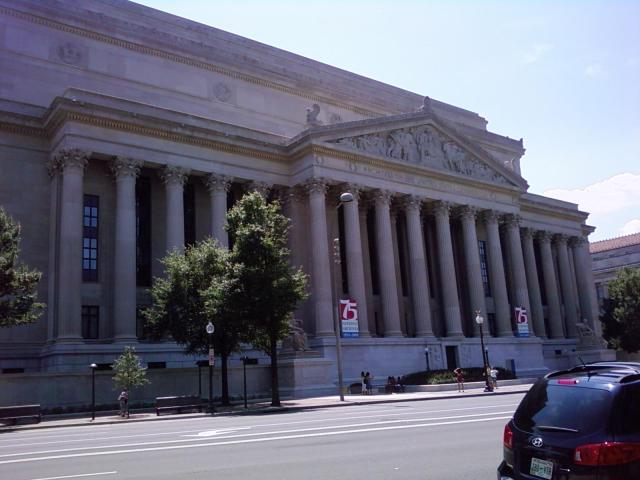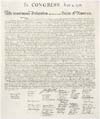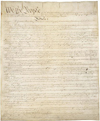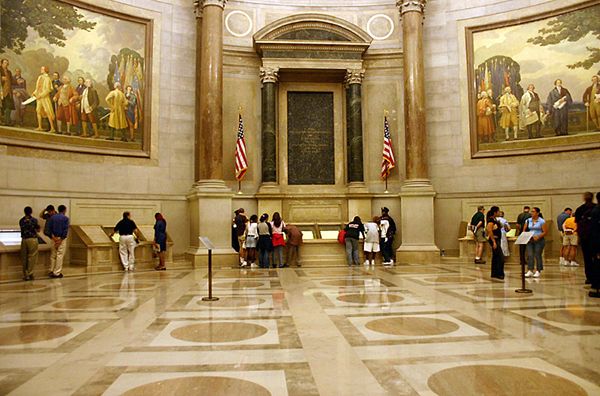Adventures at the National Archives
This post is part 17 of our Wednesday Adventure Series. Each week we will highlight something different in the Washington, D.C., Metro Area, many of which will be options for part of your own BookCrossing Journey. With so many things to see and do, how will you choose?
SPECIAL NOTICE: Don’t forget that we have some special deals for registered attendees!

 |
The National Archives houses and preserves the original copies of many of the most important historical documents for the United States. Some of the documents on display in the National Archives’ main chamber, called the Rotunda for the Charters of Freedom, include: the Declaration of Independence, the Constitution, and the Bill of Rights. Other documents on display include the Louisiana Purchase, and the Emancipation Proclamation. The Archives has a copy of the Magna Carta from 1297, however it is going off display in March 2011 for a year of restoration. |  |
Another exhibit in the National Archives is the Public Vaults. Here, you can experience what it’s like to go behind the scenes at the archives in an interactive way. You will gain access to more than a thousand pieces such as the 1823 Copper Plate of the Declaration of Independence, George Washington’s handwritten letters, Abraham Lincoln’s telegrams to generals, audio recordings from the Oval Office. The Public Vaults consist of five different vaults, named after portions of the preamble to the Constitution:
*We the People- a collection of records about American citizens including immigration records, naturalization papers, draft cards, census records, and more.
*To Form a More Perfect Union- a collection of records concerning U.S. democracy, liberty, and law including congressional debates on Prohibition, discussion of UFOs, the Kennedy assassination, and the Watergate scandal.
*Promote the General Welfare- a collection of records about the U.S. frontiers including an exhibit about the moon landing and original patent drawings for famous objects such as the typewriter, pencil, and phonograph.
*Provide for the Common Defense- a collection of documents about wars and diplomacy including records from wars from the Revolutionary War to the Persian Gulf War, recordings from the Cuban Missile Crisis, and stories of heroism, inspiration, and sacrifice.
*To Ourselves and Our Posterity- a collection about the National Archives itself.
In the lower level of the archives, there is a café and the William G. McGowan Theater, which houses lectures or shows documentaries on a wide variety of subjects. The April 2011 schedule of events is not yet online.
The Boeing Learning Center allows you an even closer look at the documents, with copies, electronic resources, and educational workshops or presentations.
One special exhibit on display at the National Archives is called “Discovering the Civil War.†The “Consequences†portion of the exhibit will be on display at the Lawrence F. O’Brien Gallery in the National Archives Building through the Sunday of our convention (after which time the exhibit will move around the country). The exhibit features milestones and lesser-known documents about the Civil War including photos, an un-ratified version of the 13th amendment, and the Constitution of the Confederacy.
It wasn’t until 1934 that Congress decided to establish a national archive for documents. Until that time, each branch and department in the government was responsible for maintaining its own collections and records, resulting in the loss or destruction of many valuable documents. The National Archives now houses both classified and public domain documents created by the U.S. federal government, as well as materials from other sources or governments. There is currently a project with Google in place to digitize many of the public domain documents.
The National Archives and Records Administration maintains twenty-one facilities in different regions as well as the Presidential Library system, of which there are thirteen across the country. Another interesting function of the Archives is to declare new amendments to the U.S. Constitution. A proposed amendment needs three-fourths of the states to ratify it. The National Archives and Records Administration is in charge of keeping track of this.
A visit to the National Archives is one of the Friday morning Early Bird choices for the 2011 BookCrossing Convention. Though it does not take too long to look at the documents in the rotunda, the National Archives recommends planning on a visit of at least 90 minutes because of all the other exhibits and the interactive learning center. Because of the sensitive condition of many of the documents on display, photography and videotaping is not allowed inside the National Archives.





